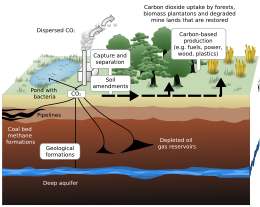capturing and long-term storage of carbon. Most often used in reference to the capturing and retention of atmospheric carbon dioxide through biological. chemical. or physical processes. Trees sequester carbon through photosynthesis.
Carbon sequestration (or carbon storage) is the process of storing carbon in a carbon pool. Carbon sequestration is a naturally occurring process but it can also be enhanced or achieved with technology, for example within carbon capture and storage projects. There are two main types of carbon sequestration: geologic and biologic (also called biosequestration).
Carbon dioxide (CO
2) is naturally captured from the atmosphere through biological, chemical, and physical processes. These changes can be accelerated through changes in land use and agricultural practices, such as converting crop land into land for non-crop fast growing plants. Artificial processes have been devised to produce similar effects, including large-scale, artificial capture and sequestration of industrially produced CO
2 using subsurface saline aquifers or aging oil fields. Other technologies that work with carbon sequestration include bio-energy with carbon capture and storage, biochar, enhanced weathering, direct air carbon capture and sequestration (DACCS).
Forests, kelp beds, and other forms of plant life absorb carbon dioxide from the air as they grow, and bind it into biomass. However, these biological stores are considered volatile carbon sinks as the long-term sequestration cannot be guaranteed. For example, natural events, such as wildfires or disease, economic pressures and changing political priorities can result in the sequestered carbon being released back into the atmosphere. Carbon dioxide that has been removed from the atmosphere can also be stored in the Earth's crust by injecting it into the subsurface, or in the form of insoluble carbonate salts (mineral sequestration). These methods are considered non-volatile because they remove carbon from the atmosphere and sequester it indefinitely and presumably for a considerable duration (thousands to millions of years).
To enhance carbon sequestration processes in oceans the following technologies have been proposed but none have achieved large scale application so far: Seaweed farming, ocean fertilisation, artificial upwelling, basalt storage, mineralization and deep sea sediments, adding bases to neutralize acids. The idea of direct deep-sea carbon dioxide injection has been abandoned.

